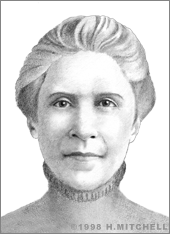Harriet Russell Strong
During the early decades of settlement of what is today known as the bustling metropolitan area surrounding Los Angeles, Calif., Harriet Russell Strong was involved in a variety of fields and causes there, from water conservation and farming to improving education and women’s rights. Her inventions of new types of dams and water storage systems represented major breakthroughs in dry-land irrigation that helped farmers throughout the southwest. Despite her lack of a formal education, her persistence and determination throughout her life lead her to make a difference in many lasting and invaluable ways.
Born in upstate New York on July 23, 1844, Strong moved west as a child and grew up in the mining communities located along the California/Nevada border. She married Charles Strong, who was 18 years her senior, and the pair bought 320 acres of land from Pio Pico, the last Mexican governor of California, in 1867.
While living on the property, called Rancho del Fuerte, Strong became interested in ways to better irrigate dry land. She invented and patented a flood control/storage dam system that incorporated several dams that served as “backups” to one another in case of a break. The key to the design was that each dam section was to be structurally supported by the water pressure from the adjoining, preceding dam. The design allowed for a controlled and uniform regulation of water flow. With this she was able to introduce winter irrigation on her ranch, where she and her husband grew walnuts, citrus fruits, pampas grass and pomegranates.
When her husband died in 1883, Strong was left in debt with four daughters to raise on her own. She took over the management of the ranch and hoped to find fortune with her inventions, but despite her three patents, found them unprofitable. However, she developed an innovative process for growing brightly colored pampas plumes, which were popular with milliners around the world. This lucrative business helped her make enough money to later buy more land, which she leased for truck farming; she also drilled three successful oil wells on her property and formed a water company. Meanwhile, by 1887 her walnut orchards began to flourish and, at 25 miles long, became the largest in the country, earning her the moniker “Walnut Queen.” Her irrigation system also became widely adopted throughout the region and was credited with speeding the growth of Southern California’s food-producing areas. By 1890, Strong had accumulated a substantial fortune; she began to turn her attention toward societal causes.
During the 1890s, she traveled across the continent with Susan B. Anthony to promote women’s suffrage, education and independence. A dream was realized for her and for millions of American women when they won the vote in 1911. She also became the first female member of the Los Angeles Chamber of Commerce, founded the Ebell Club, was elected the first President of the new feminist Business League of America, and served as a Director of the Los Angeles Philharmonic. She also became the first woman Trustee of the University of Southern California Law School. Strong also spoke before Congress on Water Conservation; she was one of the first to advocate bringing water from the Colorado River to Los Angeles.
In addition, in 1905, Strong began raising money to save the adobe known as Pico Mansion, built by Pio Pico in 1870 in what is now Whittier, California. The site was destined for demolition until she undertook a massive renovation effort, which became a great success. In 1917 she deeded the property, now known as Pio Pico, to the State of California. It became a state park in 1927.
Strong advocated for water conservation and women's rights for the rest of her life, until her death in 1926. In 1935, the Hoover Dam was completed using some of Strong's ideas that she had presented to Congress years before.


